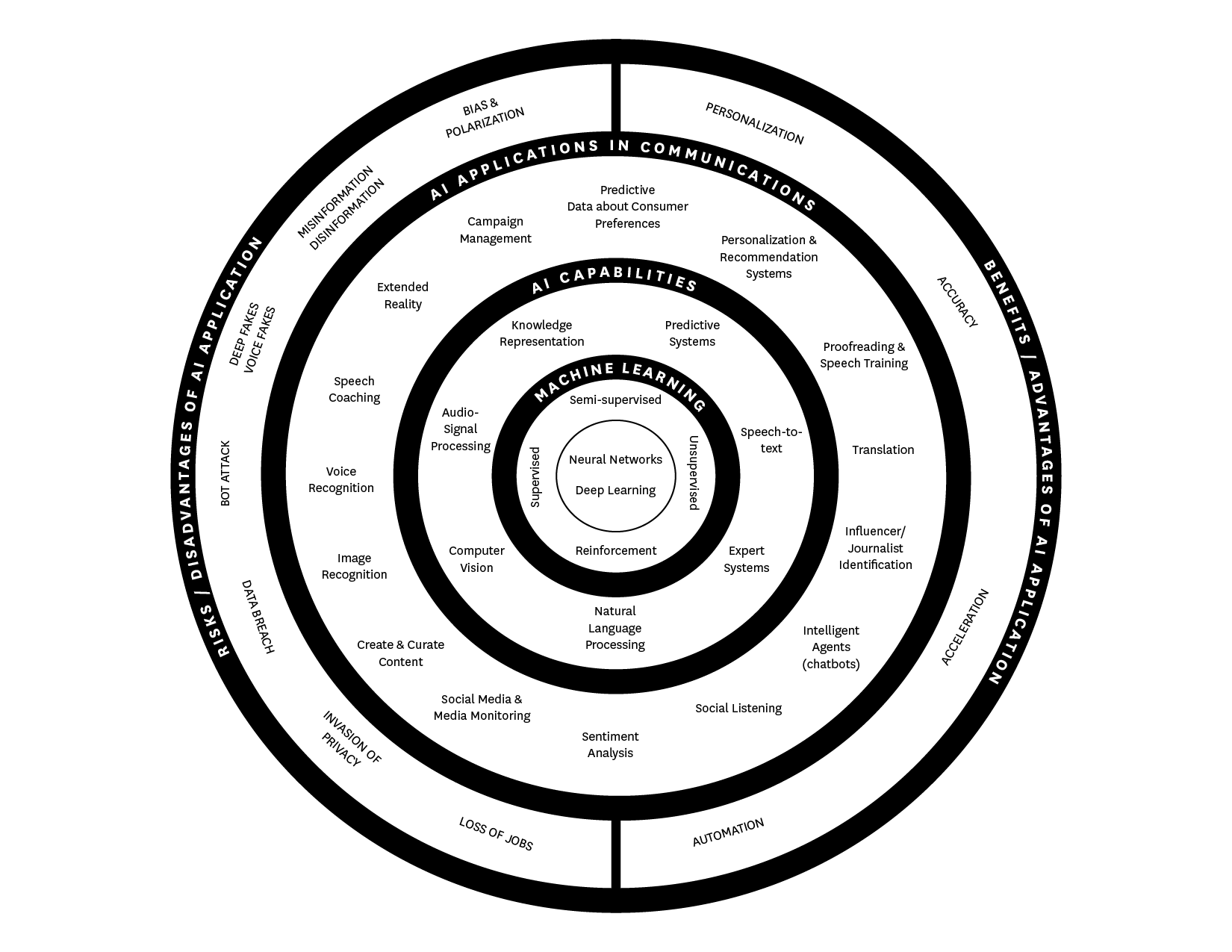
Manuelita Maldonado was the 2020 winner of the Makovsky Best Master’s Thesis of the Year Award. This blog post is based on her thesis research, “The Rise of Intelligent Machines: How Artificial Intelligence is Transforming the PR Industry.”
Thanks to science fiction characters like Hal, from 2001: A Space Odyssey, Ava from Ex-Machina or even The Terminator, we tend to think of artificial intelligence as a super-intelligent machine that will destroy or replace humanity forever – but that ultimately belongs to the future and has yet to be invented. But the truth is that this revolutionary technology is already here, and it is changing our lives in more ways that we can count. From what Netflix show to watch next to what route to take during our morning commute, AI algorithms are constantly helping us make decisions.
In the field of public relations, this new relationship between humans and intelligent machines is enabling PR professionals to create data-driven campaigns, automate repetition-based tasks, analyze online conversations, predict a crisis and even produce personalized content. But how knowledgeable are PR scholars and industry experts about the impact that AI technologies are having in the field of public relations and, most importantly, why should they care?
AI in PR: The Conversation Has Just Begun
Even though the number of AI tools available for PR professionals is exponentially growing, there seems to be little understanding of the impact this technology is having on the industry. For example, the USC 2019 Global Communications Report showed that 86% of PR professionals and students considered themselves “somewhat” or “not at all” knowledgeable on the application of artificial intelligence in communications. However, a significant portion of PR specialists reported they were using tech services to conduct media monitoring, website analytics, social media management and social listening, all of which are likely using some form of AI. These findings suggest that there currently exists a significant misunderstanding —perhaps a knowledge gap— about the actual state of AI technology advancement as it can be applied to supporting or evolving the capabilities within the PR industry.
Fortunately, this trend is slowly starting to change. For example, in 2018 the Chartered Institute for Public Relations (CIPR) founded the #AIinPR panel to study the impact of artificial intelligence on public relations and the wider business community. In 2019, the ICCO Global Summit dedicated two sessions to exploring the PR tech landscape and discuss how to prepare for the age of artificial intelligence and automation. Additionally, the PRSA LA chapter hosted the panel “AI, Tech and the Future of Public Relations” where professionals discussed the current state of technology in PR, the myth that AI will replace PR practitioners, and the reasons why tech companies may need to rely more heavily on PR experts in the future.
Not surprisingly, public relations agencies have also started to conduct their own studies. Examples of these reports are FleishmanHillard’s “Artificial Intelligence & Communications: The Fads, the Fears, the Future” and Edelman’s “2019 Edelman AI Survey.”
What Is AI and Why Should PR Professionals Care?
Coined in 1956 by a group of computer scientists gathered at a conference at Dartmouth College, artificial intelligence was defined by Simon A. Herbert as a branch of computer science that studies the phenomena that occur when computers perform tasks that, if performed by humans, would be regarded as requiring intelligence.
In the field of communication, AI’s ability to process human language has allowed companies to understand individual behaviors, preferences, beliefs and interests to deliver more efficient campaign strategies. The following graph is a constellation of some of the fields, capabilities, applications, advantages and risks of using AI technologies in the field of communication (see fig. 1).

Figure 1: Visual representation of the capabilities, applications, advantages and risks of AI deployment in the field of communication.
According to AI marketing expert Christopher Penn, AI has brought three main benefits for public relations practitioners: automation, acceleration and accuracy.
- Automation: AI is allowing PR professionals to automate repetitive tasks such as tracking media coverage. Not only is automation taking over some of the busywork that comes with the practice of public relations, but it is also augmenting PR professionals’ ability to obtain insights in a matter of seconds.
- Acceleration: AI is enabling PR professionals to obtain insights from the digital world in real-time. This benefit can be crucial during a social media boycott, for example, when conversations spread rapidly and time can be your most valuable asset.
- Accuracy: AI is allowing PR professionals to accurately quantify people’s feelings and opinions about a brand and compare that sentiment against other metrics like engagement, stock price, or sales.
Automation, acceleration, and access to more accurate metrics like the scope of reach, sentiment, and engagement rates with the help of AI-powered platforms are transforming the public relations industry. On the one hand, new types of skills are being needed: big data analytics, user experience, and predictive artificial intelligence are all proficiencies required to compete with marketing and advertising and justify the value and effectiveness of the PR industry. On the other hand, having cheaper, faster, and better access to relevant information is giving PR practitioners the ability to focus on other activities such as creative thinking, strategic planning and instinct —all essential attributes of communications professionals that no machine will ever offer in our lifetimes.
![]()
Manuelita Maldonado was a Graduate Research Associate at the USC Annenberg Center for  Public Relations. She graduated from the University of Southern California with a Master’s in Strategic Public Relations in May 2020 and now works as a Tech Public Relations Intern at Golin.
Public Relations. She graduated from the University of Southern California with a Master’s in Strategic Public Relations in May 2020 and now works as a Tech Public Relations Intern at Golin.



